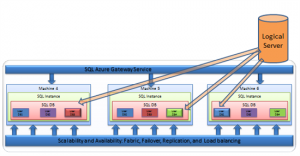
The most visited post here is the one on my experience with performance on Azure, using WA SQL and VMs. There seems to be a lot of interest in the subject, so in the links for this week, there are quite a few links to articles by the Microsoft SQL Server Support Team on Windows Azure SQL Server. Articles on jQuery, CSS and scalabilty are also featured.
- Microsoft SQL Server Support Team’s Windows Azure SQL Database (WASD) Primer is the first of a series of articles on what is known as Windows Azure SQL – the Azure hosted Platform as a Service version of SQL Server. This first article presents some of the terminology used on the article series on WASD and includes some reference links that help understanding the differences between WASD and a “normal” SQL Server installation.
- Is my query running fine in the cloud? is another of the articles in the series. Addresses several resources that can be used to determine causes of performance issues with WASD – available DMVs, performance, connectivity and resource usage related, execution plans. Again, it includes references to other relevant articles. It should also include a link to scripts to collect DMV info, updated for WASD, but I couldn’t find the article.It is still very informative, even without the link.
- Do I need to upgrade my DBA skills for the cloud?, yet another article in the series, addresses some of maintenance / administration tasks needed, once the database is online. The series includes two more articles, on firewall configuration to secure access to the database and on getting a database to Azure, that are accessible from any of the articles in the series.
- Keeping up with the WASD subject, Thomas LaRock’s How to: alter table in windows azure sql database without filling up your transaction log describes an approach to deal with transaction log size limitations in WASD, specifically when dealing with table changes in tables with a very big number of records. Such changes can cause the 1GB limit log size change per transaction and the articles suggests a strategy to avoid that.
- Slightly changing subjects, Brent Ozar’s What Developers Need to Know About SQL Server presents advice gathered through a Twitter session on what DBA’s think developers need to know about SQL Server. It has very interesting advice for developers using SQL Server for persistence.
- Dwain Camps’s Performance of the SQL MERGE vs. INSERT/UPDATE analyzes the MERGE statement in terms of performance and concludes that the added flexibility comes with a small price in terms of performance.
- Joe Celko’s Window Functions in SQL addresses the whole range of windowing functions in SQL, from aggregate to ranking and analytic functions, with some examples included. A very interesting read.
- Pinal Dave wrote a series of 21 articles on the basics of Big Data. Big Data – Learning Basics of Big Data in 21 Days – Bookmark is an index to all the articles in the very informative series.
- Changing subjects yet again, Yogesh Mankani’s Best jQuery Tutorials of Year 2013, presents multiple very interesting jQuery usage tutorials.
- Rajni Setia’s Useful Cheat Sheets for Designers and Developers presents a large and useful set of cheat sheets for web designers and developers.
- Martin Angelov’s 12 Awesome CSS3 Features That You Can Finally Start Using presents 12 CSS 3 features that are now supported by all major browsers (which include IE 10 and later, only, which means IE 9 is out of this group).
- Craig Butler’s CSS3 Inheritance Tips and Tricks presents some usually overlooked cascading features in CSS3.
- Jeremy Girard’s Selling Responsive Web Design To Clients, starting with a situation where a customer wasn’t interested on having a website redesign, presents a few benefits of responsive design, that usually are not primary motivators for responsive design adoption and concludes that these benefits can be, by themselves, a good way to sell responsive design.
- Finally, Thierry Schellenbach’s Design Decisions For Scaling Your High Traffic Feeds presents the author’s experience while building the feed system at Fashiolista to sustain high traffic conditions.
That’s all for this week, thanks for reading.
The image used on this post was originally posted on Wayne Walter Berry’s Inside Windows Azure SQL Database